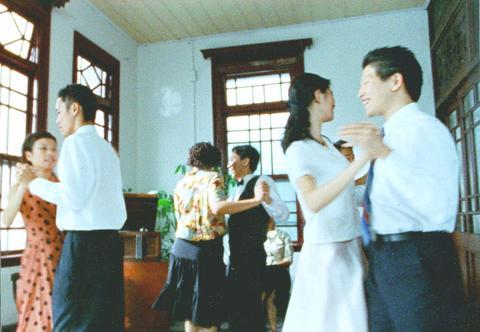Some of the salient features of Taiwanese-language pop songs are abundant sentimentalism, dense laments and sad stories about life, which are reflected in both the lyrics of many of the songs as well as the syrupy vocals.
Sadness is also a word that is often used to describe Taiwan's recent history, its days as a colony, the war, the 228 Incident and the White Terror, among other travails. Many Taiwanese recall a sad past and forget that during the 1930s and 1940s it was completely a different picture.

PHOTO COURTESY OF CHIEN WEI-SSU AND KUO CHEN-TI
Director Chien Wei-ssu (
"I've always thought that Taiwan's history is filled with sadness. But we've found out that there were times of jollity and youthfulness," Chien said.
Viva Tonal is a documentary tracing the emergence of Taiwan's record industry, as well as its pop songs. Through the music of Taiwan's earliest vinyl records and antique phonographs (provided by music collector Lee Kun-cheng (
The 1930s and 1940s were a time of big bands, ragtime jazz and ballroom dancing. Fashionable people would sit along boulevards drinking coffee, dancing the waltz and the fox trot, or just listening to their phonographs.
The lyrics to a Taiwanese-language song of the time, A Dance Era encapsulates this feeling: "We are the modern girls, free to go where we like/We don't have a care, don't know much about the world/We only know that these are modern times, and we should be sociable/Men and women in two lines, dancing the fox trot is my favorite."
Released in 1929, the song is up-beat and suitable for a fox trot. It was sung by Chun-chun (
The filmmakers interviewed old singers for their film, including Ai-ai (
The Columbia Record Company of Japan set up its Taiwan branch in Taipei's Ximenting in 1929 and hired local songwriters to publish Taiwanese-lang-uage records. Soon, Victor Records also set up a Taiwan branch.
As a result, perhaps, local people's recreational habits gradually changed from going to temple fairs or local operas, to listening to records and going to dances.
Woven into the narrative of the documentary is the rapid modernization which Taiwan experienced during these times, with the introduction of railways, electricity and running water. Men cut their queues and women stopped binding their feet. Such a new social atmosphere is reflected in the lyrics of A Dance Era.
Viva Tonal, which roughly means "great local sounds" in Italian, was printed on the old Columbia records. As for the film itself, it offers vivid images of Taiwan's history. The only criticism is that it could be tighter, as the narration of the history is a bit stodgy.
But the film does convey an image of happier times. Former president Lee Teng-hui (
Film Notes:
Directed by: Chien Wei-ssu and Kuo Chen-ti
Running time: 104 minutes
Taiwan Release: May 15, with a special English-subtitled screening on Wednesday, May 26, 10pm at the President Theater in Ximending

On April 26, The Lancet published a letter from two doctors at Taichung-based China Medical University Hospital (CMUH) warning that “Taiwan’s Health Care System is on the Brink of Collapse.” The authors said that “Years of policy inaction and mismanagement of resources have led to the National Health Insurance system operating under unsustainable conditions.” The pushback was immediate. Errors in the paper were quickly identified and publicized, to discredit the authors (the hospital apologized). CNA reported that CMUH said the letter described Taiwan in 2021 as having 62 nurses per 10,000 people, when the correct number was 78 nurses per 10,000

As we live longer, our risk of cognitive impairment is increasing. How can we delay the onset of symptoms? Do we have to give up every indulgence or can small changes make a difference? We asked neurologists for tips on how to keep our brains healthy for life. TAKE CARE OF YOUR HEALTH “All of the sensible things that apply to bodily health apply to brain health,” says Suzanne O’Sullivan, a consultant in neurology at the National Hospital for Neurology and Neurosurgery in London, and the author of The Age of Diagnosis. “When you’re 20, you can get away with absolute

May 5 to May 11 What started out as friction between Taiwanese students at Taichung First High School and a Japanese head cook escalated dramatically over the first two weeks of May 1927. It began on April 30 when the cook’s wife knew that lotus starch used in that night’s dinner had rat feces in it, but failed to inform staff until the meal was already prepared. The students believed that her silence was intentional, and filed a complaint. The school’s Japanese administrators sided with the cook’s family, dismissing the students as troublemakers and clamping down on their freedoms — with

As Donald Trump’s executive order in March led to the shuttering of Voice of America (VOA) — the global broadcaster whose roots date back to the fight against Nazi propaganda — he quickly attracted support from figures not used to aligning themselves with any US administration. Trump had ordered the US Agency for Global Media, the federal agency that funds VOA and other groups promoting independent journalism overseas, to be “eliminated to the maximum extent consistent with applicable law.” The decision suddenly halted programming in 49 languages to more than 425 million people. In Moscow, Margarita Simonyan, the hardline editor-in-chief of the